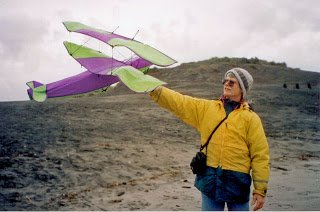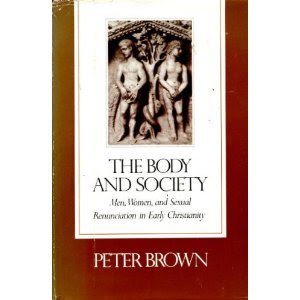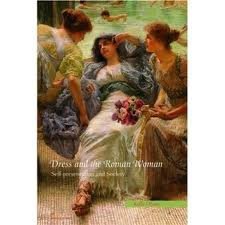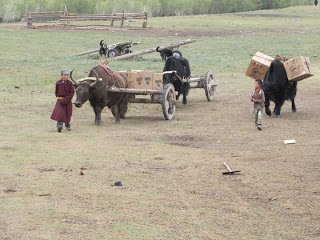
Blog & Resources
Looking for my thoughts on everything from bioethics to movies? You came to the right place. And while you’re here, check out my free downloadable resources.
Sign up to be notified when new posts release.
Comps
I handed in my third comp exam today at 10 AM. I'm set to do orals next week. I'm glad to be finished with this portion. We went out with my sister's family for dessert to celebrate. We used part of a leftover gift card from my hubby's family and Christmas money from my parents that we'd never gotten around to using. It seemed appropriate.
The exams were tough, and I won't know if I passed until next week. But for now I'm thankful to have it behind me, thankful for my family's support, and glad to see Thanksgiving on the calendar.
My sister's on her way over with old episodes of Burn Notice.
Whirlwind
Last night they took me to a place called Trio's for dinner, where I enjoyed my first-ever shrimp enchilada. Yum. And I saw fall colors--sorely missing in Dallas.
The women at Fellowship Church in Little Rock plan to do both my Colossians and Philippians studies this spring. So I was providing an introduction to the cities of Philippi and Colossae in the ancient world and how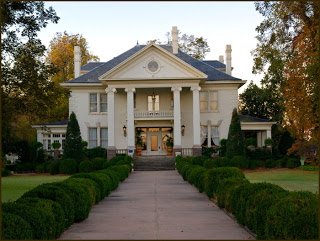 what we know about them illuminates the text. (Or maybe I've just found a way to show "what I did on my vaction" slides under the cloak of legitimacy?)
what we know about them illuminates the text. (Or maybe I've just found a way to show "what I did on my vaction" slides under the cloak of legitimacy?)
Afterward, Susan treated four of us to a tour and exquisite lunch at the lovely Marlsgate Plantation. From there we went to Starbucks. Yeah, it was a rough day.
The women dropped me off at the airport, and when I got to my gate I learned that the flight was overbooked, and they didn't have a seat for me. Southwest Airlines said if I had to spend the night in Little Rock, they would pay for my hotel. But I didn't want to spend the night in Little Rock. I was supposed to land at 6:30, meet my friend Kelley at the Dallas Museum of Art, and hear Stacy Schiff talk about her new Cleopatra book at 7:30.
Comps
I am getting tired of hearing myself talk, so I'm going to explain my exam situation here. That way I can quit dominating conversations by repeating myself. I appreciate people asking. They have been very supportive. I am not tired of people asking; I am tired of hearing myself answer. :)
What is it I am doing, exactly, folks want to know. What is involved in taking PhD comps?
I can't speak for any other program--only the one I'm in. But for me, "comps" is shorthand for comprehensive examinations. I have three exam fields--women in antiquity, the novel, and Artemis/Ephesus from 100 BC- 100 AD (or 100 BCE to 100 CE). I had to prepare three bibliographies, one for each field, and get them approved. These are the books I've been reading for the past two years.
On four different dates spanning 20 days I take an exam. For the first three I receive an email at 10 AM on the stated day. It contains two questions from one of my examiners. I choose one to answer and write 20-25 pages within 24 hours. By 10 AM the next morning I am to email my paper to my three examiners and the administrative assistant. I have finished exam one (women in antiquity); the second one (Artemis/Ephesus) I am to take tomorrow (Tuesday).
The last one, the novels exam, I have scheduled for next Monday. After that I show up for an oral exam (Dec 1), where we're all in the same room and I answer questions for 2 hours. IF I pass all this, I can start writing my dissertation.
So I still have a long way to go. But one step at a time I'm getting there. And learning a lot in the process! (Including "I will be with you.") Thanks for your support.
Remember Enron?
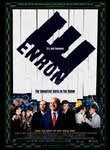 Often the most powerful sermons don’t come from the pulpit. Case in point: This weekend my hubby and I watched a flick that was the best example I think I’ve ever seen of how somebody can “gain the whole world but lose his own soul.” The DVD was a 2005 documentary, “Enron: The Smartest Guys in the Room.” Talk about hubris.
Often the most powerful sermons don’t come from the pulpit. Case in point: This weekend my hubby and I watched a flick that was the best example I think I’ve ever seen of how somebody can “gain the whole world but lose his own soul.” The DVD was a 2005 documentary, “Enron: The Smartest Guys in the Room.” Talk about hubris.
The Body and Society
I love this video!
A friend of my brother-in-law, Mark, produced this life-affirming video. Love it!
Council for Life from Jonathan Culp on Vimeo.
They Were What They Wore
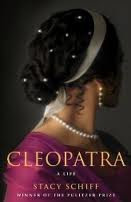 once bought his mistress a pearl that cost more than what 1,200 professional soldiers earned in a year.) Our costume jewelry and cubic zirconia make it difficult to imagine what a strong social statement a woman would make if she emerged dripping in a dowry’s worth of “frosting” in public. But suffice it to say, such an act would scream “pretentious.”
once bought his mistress a pearl that cost more than what 1,200 professional soldiers earned in a year.) Our costume jewelry and cubic zirconia make it difficult to imagine what a strong social statement a woman would make if she emerged dripping in a dowry’s worth of “frosting” in public. But suffice it to say, such an act would scream “pretentious.”
Why Are Americans Fat?
I read this quote in today's NY Times: "If you want to look at why people are fat today, it's pretty hard to identify a contributor more significant than this meteoric rise in cheese consumption." --DR. NEAL D. BARNARD, president of the Physicians Committee for Responsible Medicine, which challenged a federal agency's claim that eating dairy products can help dieters lose weight.
Okay, so maybe we eat too much cheese. But allow me to propose a few more possibilities.
First, my child has not had to take P.E. since seventh grade. When I as her age, we had P.E. all the way through our senior year, and that soccer semester had us running miles a day.
Second, have you seen the dessert portions at restaurants like Claim Jumpers? Six of us shared a piece of chocolate cake and couldn't finish it.
Third, have you seen the portions of food just about anywhere you eat out?
Watching TV us not the most calorie-burning activity. Now we can sit and watch pro, college, and high school sports 24/7.
Starbucks. Yum.
What do you think? Why are we so overweight?
Bieber and stuff
 We finally have the dates for my examinations: Nov 11, Women in Antiquity; Nov 16, Ephesus/Artemis 100 BCE to 100 CE; Nov 22, Aesthetics of the Novel; Dec 1, orals. Yay!
We finally have the dates for my examinations: Nov 11, Women in Antiquity; Nov 16, Ephesus/Artemis 100 BCE to 100 CE; Nov 22, Aesthetics of the Novel; Dec 1, orals. Yay!
Three Change-Your-Life, True-Story Flicks
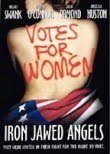 Today was my day to post over on the Tapestry blog. Here's what I wrote:
Today was my day to post over on the Tapestry blog. Here's what I wrote:
Recently in a class I teach we focused on women in church history. In addition to reading accounts of women martyrs, students watched the film “Iron Jawed Angels.” Most people don’t realize that Alice Paul, a key leader in the fight for suffrage in the USA, was a Quaker.
Driven by her conviction that God made man and woman equal, Alice Paul worked tirelessly for a constitutional amendment giving women the vote. While the film does not emphasize her faith, it does mention it.
Afterward I received this message from one of my students: “All was well until completing the reading for class today and seeing ‘Iron Jawed Angels’… The movie had an enormous impact on me. I've realized that all throughout the last few months the word that keeps coming up both within and outside of me is ‘courage.’” She went on to say that she had always thought of courage as a male quality rather than a human quality. But as a result of her Spirit-led, film-inspired clarity, her plans have shifted from spending a summer in comfort to pursuing a ministry opportunity in Ethiopia.
Fear not! How many times do we read that in Scripture? Yet sometimes in facing down our fears it helps to hear or see how others in the "cloud of witnesses" have refused to cower. And in addition to Iron Jawed Angels, two fairly recent additional films--these overtly Christian--come to mind.
The first is “Pray the Devil Back to Hell.” Imagine that all you want to do is live in peace, but soldiers—many of them children—terrorize your town. You endure hunger, thirst, homelessness, violence, and trauma like seeing your spouse knifed to death and your daughter raped.
Such was the plight of women all across Liberia in 2003. That is, until Christian and Muslim women united in non-violent protest and prayer, and in doing so changed the course of Liberia’s history.
Their remarkable story is told in the 2008 documentary, “Pray the Devil Back to Hell.” When peace talks stalled, these women donned white T-shirts, barricaded the doors, and made the negotiators inside go hungry and thirsty (like the rest of Liberia’s citizens) until they came to an agreement.
The surprising result was not only peace, but ultimately honor, as the women’s actions led to the election of Africa’s first female head of state. Wow.
The other film is “Malatya.” Remember the 2007 martyrs--three employees of a Turkish Christian publishing house who died for their faith? The victims, a German and two Turkish citizens, had their limbs bound and their throats slit. And this documentary tells their story.
“Malatya” is the name of the town in eastern Turkey where the events happened. And in this film viewers see news footage and hear from the martyrs’ wives, friends, and ministry partners about the tragedy and its aftermath.
The flick challenges comfortable disciples to get uncomfortable and live fearlessly, forgiving their enemies and showing love in the face of despicable injustice. I highly recommend it for personal reflection as well as group discussion. It comes with some extras including a visual prayer guide and extended scenes worth watching.
The first two movies are available by mail order at sites such as Netflix; the latter is available only for purchase. You can find it at malatyafilm dot com, where you can view a trailer.
Why not hold a movie weekend, bringing people together in your living room to watch and discuss such life-changing films? Or at your next women's retreat, set up a movie viewing room. You might just hear, “All was well until…”
Not for the Faint of Heart
Then there’s the four-month trip on the boat—probably the most sickening account I've ever read. It would be bad enough to be torn from anyone and anything you’ve ever known and lie chained below deck in the dark. But to be stuffed into a shelf where you soil yourself and lay in your waste?
At the time of its release, the book affected our nation like no story since Uncle Tom’s Cabin. And honestly the combination of these two books has made it impossible for me to hear references to our own nation’s “Christian past” without the knee-jerk need to add some qualifications.
Roots is based on something that happened to millions in our country’s history over a long period; it was not some random blip. And it was here from the beginning. Many who should have been committed to “do justice” and “do unto others” instead used scripture to justify their treachery. And the evil was systemic: People sold slaves; lawmakers protected slave owners; land owners reaped the benefits of backbreaking work; consumers enjoyed the high standard of living brought by low prices. And after more than a hundred years of all this, Southerners laid down their lives fighting to keep it that way.
Samaritan's Purse Mongolia
One of my Facebook friends posted some shots of how packages get delivered in Mongolia for the Samaritan's Purse Operation Christmas Child project. When I wrote to the source for permission to post, he sent me even more shots. Aren't these fun? There's still time to participate!
Provision!
To the Whole World...
On Saturday at the international Lausanne conference in Cape Town, South Africa, Elke Werner, founder and director of WINGS (Women's International Network in God's Service) in Marburg, Germany, showed this three-minute, Synergy-produced video during her keynote.
Rangers Win the Pennant!
For the first time in history our baseball team is headed to the World Series. Josh Hamilton was voted MVP. Have you seen his story?
Liberals Are Not Radicals
....that is, if we're talking about feminists. Just as there are many denominations within Christianity, there are different strains of thought within feminism. And sometimes they vehemently disagree with each other. The four major schools break down as follows:
• Liberal – Focus is individual solutions rather than collective. Seek reform, not revolution. Liberal feminists work within a capitalistic system laboring to change laws to provide equal opportunities for males and females. A liberal feminist measures progress in the numbers of women and men occupying positions previously considered male-only or female-only. Liberal feminism is the most “mainstream” form of the many feminisms. While socialist feminists focus on collective change and empowerment, liberal feminists focus on individual change and empowerment. Liberal feminists tend to minimize gender differences.
• Radical – Focus is collective solutions rather than individual. Seek revolution, not reform. Radical feminists believe the only way to achieve gender equality is to overhaul society. Forget passing laws here and there to make things equal. Go for revolution. Radical feminists see male domination of women as the most fundamental form of oppression, and they focus on understanding how men obtain and use power. Because radical feminism shares with socialist feminism the commitment to dramatic social change, radical feminism is often grouped with socialist feminism. Radical feminists view society as patriarchal and believe patriarchy must be transformed on all levels.
A subset of radical feminism is cultural feminism. Cultural feminists maximize gender differences. They tend to stress attributes associated with women's culture (e.g., caring, relationships, interdependence, community), insisting they must be more valued. They reject unisex thinking in favor of affirming women’s essential femaleness. They tend to de-value virtues typically attributed to men such as domination, autonomy, authority, and independence.
• Socialist feminism – Focus is collective solution rather than individual. Seek revolution, not reform. Whereas liberal feminists focus on empowering the individual, socialist feminists seek collective change and empowerment. Socialist feminists believe that capitalist societies have fundamental, built-in hierarchies, which result in inequalities. Thus, it's not enough for women individually to rise to powerful positions; instead power must be redistributed. True equality, they believe, will not be achieved without overhauls—especially economic overhauls.
• Marxist or materialist feminism – Focus is collective solution rather than individual. Seek revolution, not reform. While generally opposed to Socialism, Marxist feminists have much in common with socialist feminists. Marxist feminism is based on Marxist views of labor reform. Like socialist feminists they believe capitalism is the root of the problem, and power must be redistributed.
Additionally, the mid-seventies saw the rise of black or womanist feminism. A distinctively African-American version, this "less liberal" pool of feminism sees race, class, and gender oppression as interconnected. Womanist feminists believe that those who seek to overturn sex and class discrimination without addressing racism are themselves operating out of racism. A key text for them is the 1792 work by Mary Woolstonecraft, Vindication of the Rights of Woman.
Next time you talk to someone who calls herself a feminist, ask some questions. "Do you think that beyond physiology, men and women are essentially the same, or do you think there's something fundamentally different in maleness and femaleness?" "Do you think the solution is changing laws or full-on revolution?" You might have a fascinating discussion.
Breast Cancer Awareness Week
My Tuesday post over at the Tapestry Blog was about Breast Cancer Awareness. Check it out.
Carin' for Erin and stuff
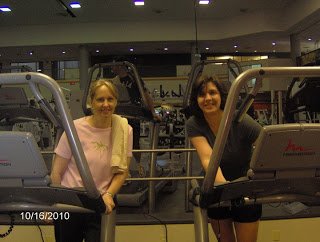 That's my friend Kelley Mathews and me. Yesterday at the Baylor Landry Center we walked/ran the "Carin' for Erin 5K" in honor of our friend Erin Teske, who just finished her fourth chemo treatment for breast cancer. Some 50+ friends of Erin across the globe joined in solidarity with her by burning some calories.
That's my friend Kelley Mathews and me. Yesterday at the Baylor Landry Center we walked/ran the "Carin' for Erin 5K" in honor of our friend Erin Teske, who just finished her fourth chemo treatment for breast cancer. Some 50+ friends of Erin across the globe joined in solidarity with her by burning some calories.
Turns out yesterday was also the day for the Susan G. Komen 5K, which is why the childcare workers at Landry got a little freaked when they thought Kelley was dropping off her son and going elsewhere to join the masses. Uh, no.
October is breast cancer awareness month. More on that coming Tuesday...
Today Gary is at a missions conference talking to folks about his work in East Africa. Meanwhile, my girl and I headed across town to witness the baptism of our friend Valerie Talley. Val is a twentysomething friend from our previous church. What a joy!
Oh, and for those following our church search (ours closed in May), we have finally found a home. Centerpoint is seven minutes from our house. Some things we love about it are that its people seem to love and take good care of each other. It's racially diverse. And instead of having a sole senior pastor, it has three rotating teachers. Also our Sunday morning class is not divided by age, so it consists of singles, young marrieds, folks like us trulyweds, retirees... And the church is committed to planting a new church when they reach 200, so they never become a "mega." There are lots of ways to structure church, but these are some things we consider important. We're so grateful to have found a place we love that's nearby. And I also have to say we're glad we can end the search!
Cuz frankly visiting lots of different churches can be kind of yucky. Turns out, in some places the greet-the-visitors time feels like it's not really about getting to know anybody. It's more like the regulars are trying to shake as many hands as possible. Hi-bye.
And some of the teaching we heard sounded more like psychobabble or political propaganda--or was just plain wrong. One Father's Day sermon included this: "Husbands, your job is to take whatever your wife dishes out." Uh-uh.
Sometimes when folks encouraged us to complete visitor cards, they assured us that "nobody will visit you." Funny. We might have appreciated a chance to talk face to face.
And some of the web sites we explored told us budget info and how many people attended and how the church's numbers had grown, but nothing about what they believe. So what's most important to them? One web site even talked about how much the congregation likes to drink beer, but nothing about their core values. Or maybe that was a core value?
Why gather as the church? Because Christ-followers need community. We can't share the cup and break bread in remembrance of Him on the Internet. We can't take a meal (or receive one) or hug someone hurting (or receive hugs) via the television. It's tough to get baptized by live feed. And we can't really grow in our faith unless we have a safe place where we can confess our sins to one another and admit we're broken and hold each other accountable. We need "Jesus with skin on." And we have this wonderful promise that "wherever two or more are gathered in My name, I am there in the midst of them." Two or more. I like that.

